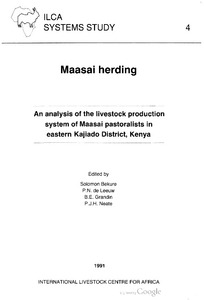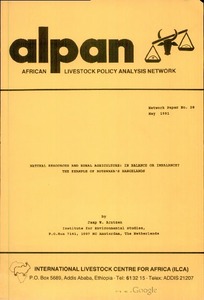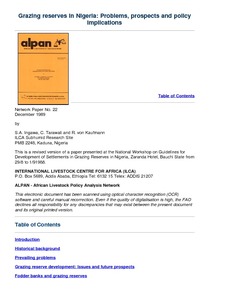Selling wealth to buy poverty: the process of the individualization of landownership among the Maasai pastoralists of Kajiado district, Kenya, 1890-1990
This thesis gives an overview of the Maasai livestock economy as it has developed between 1890 and 1990. Particularly, it analyses the processes and policies of land use and landownership of the Maasai pastoral areas in Kajiado district, Kenya, from the arrival of the Europeans until the recent massive individualization of land tenure. The loss of grazing pastures due to increased cultivation, the establishment of game parks and mineral exploitation is said to undermine the livestock economy of Maasai pastoralists in Kajiado district.
Taking the bull by the horns: NGOs and pastoralists in coalition
Such is the vagary of rainfall throughout Africa's rangelands that almost all pastoral communities face cycles of good and hardship years. During good years herders increase and diversify their herds, whilst consecutive hardship years or `pastoral drought,' human and livestock disease, or livestock theft may result in large livestock losses and the consequent temporary collapse of household food production.
Maasai herding: An analysis of the livestock production system of Maasai pastoralists in eastern Kajiado District, Kenya
The first chapter gives a brief description of a pastoral production system, as envisaged by the study team and outlines the multi-disciplinary approach of the study, its sampling design and the data collected. Chapters 2 & 3 describe Kenya's biophysical and socio-economic environments, within which the Maasai livestock production system operates. The biophysical environment of the study site is described in detail in Chapter 4. Chapter 5 describes the social organization of the Maasai and how it affects their use of livestock and grazing resources.
Natural resources and rural agriculture: In balance or imbalance? The example of Botswana's rangelands
Assesses the effect (balance or imbalance) of the present relationships between the natural resource base and human activities; examines the role of some potentially destabilising forces, i.e, international markets, government programmes and socio-economic stratification; and reviews government's role in terms of its contributions to prudent natural resource management and options for the promotion of sustainable rural development.
Ley 6.290 - Ley de conservación del suelo agrícola.
La presente Ley introduce el marco normativo que rige las acciones tendientes a la conservación del suelo agrícola, es decir al mantenimiento y mejoramiento de su capacidad productiva.
Los bosques y la alimentaria
Unasylva examina el significado de los bosques para la seguridad alimentaria, formulando la siguiente pregunta: Cmo hacer que los programas y actividades de desarrollo forestal sirvan para asegurar econmica y materialmente a todo el mundo, en todo momento, el acceso a su alimento? En el artculo de fondo M. Hoskins expone cmo contribuyen - y cmo podrn contribuir - los bosques a la seguridad alimentaria, y sugiere estrategias para incorporar a las actividades de desarrollo forestal elementos de seguridad alimentaria.
Foresterie et sécurité alimentaire
Le prsent numro d'Unasylva examine en dtail le rapport entre la foresterie et la scurit alimentaire et se pose la question suivante: Que peut-on faire pour que les programmes et activits de dveloppement forestier contribuent dans la mesure du possible assurer l'accs conomique et physique aux produits alimentaires pour tous et en tout temps? Dans l'article de fond, M.
Forestry and food security
The current issue of Unasylva takes a long look at the relationship of forestry with food security, and asks the question, ''How can forestry development programmes and activities become as relevant as possible in ensuring economic and physical access to food by all people at all times?" In the lead article, M. Hoskins sets out the actual and potential contributions of forestry to food security, and suggests practical strategies for the incorporation of food security components in forestry development activities.
INTEGRATION OF TRANSHUMANT PASTORALISM AND IRRIGATED AGRICULTURE
Agricultural development projects in the fertile and most well watered areas of arid and semi arid Africa usually deny access to nomadic pastoralists whose production system and livelihood depend upon such areas in the dry season and during frequent droughts. The result can be degradation of range resources through overgrazing, and greater vulnerability of pastoralists.
Grazing reserves in Nigeria: Problems, prospects and policy implication
Grazing reserves in Nigeria are areas set aside for the use of pastoralists and are intended to be the foci of livestock development. The stated purpose of grazing reserves is the settlement of nomadic pastoralists they offer security of tenure as an inducement to sedentarization through the provision of land for grazing and permanent water. This paper reviews problems associated with grazing reserves and offers suggestions to make them more productive and relevant to the needs of the intended beneficiaries.







